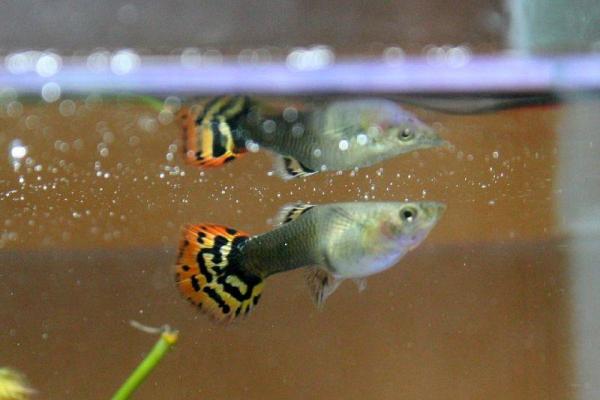How Are Fish Born?


The word "fish" refers to numerous species. So it should not be surprising that there is more than one way to reproduce and be born. Most fish are oviparous, that is, they reproduce through eggs that are hatched after being laid by the parents, as in birds. However, there are also ovoviviparous or viviparous fish, meaning they are able to hatch eggs within themselves and perhaps even give birth to offspring. Moreover, there are even hermaphrodites that have reproductive organs of both sexes.
The following AnimalWised article explains how fish are born and includes other interesting facts about fish reproduction.
How do fish reproduce?
Fish are only a fraction of the aquatic animals that exist, which means that they are embedded in a complicated dynamic of predators and competitors. Therefore, fish reproduction is not an ecologically simple matter.
In reproduction, courtship strategies to attract females, such as dancing, nest building, etc., are common. In addition, different species have developed different methods to ensure the continuation of the species. Reproduction is almost always sexual, as fish, like most animals, are born with a specific sex (male-female).
Generally, there are three different types, we will see each of them below.
Reproduction of oviparous fish
Most fish are oviparous and as such are fertilized externally. The female lays the eggs, and they are fertilized by the male releasing his sperm into the water. The eggs may be laid on the sea floor, attached to rocks, or floating in the sea.
Reproduction of ovoviviparous fish
Ovoviviparity has some aspects in common with both oviparity and viviparity. Ovoviviparity is a type of embryonic development in which the fish lays eggs, but they remain in the female's body until the embryo is fully developed. Hatching may occur immediately before birth or immediately after egg laying. Ovoviviparity occurs in many sharks and other fish, in some reptiles, and in various invertebrates.
Reproduction in viviparous fish
Viviparous animals are those that reproduce by internal fertilization and whose embryos develop in specialized organs in the womb. In this way, the offspring grow until they are fully formed inside the mother, who nurtures them. When they are fully developed, the mother gives birth to them. Once born, the young can swim freely and independently in the aquarium.
If you want to learn more about this topic, you should check out the following article about fish reproduction, where we explain in more detail the different ways fish reproduce.

Can fish be hermaphrodites?
Many species of fish are hermaphrodites, meaning they have both male and female reproductive organs and can become sexually mature as a female and then change into a male or vice versa. Of the 33,000 different species of fish, about 2% exhibit some type of hermaphroditism.
There are, essentially, two types of hermaphrodism in fish, these are:
Simultaneous hermaphrodites
These are species that have both sexes throughout their lives and can alternate between becoming a male or a female at a given time depending on the needs of the species. In fact, this change can occur even several times in the same day, as in the famous case of the Pale Sawfish (Serranus tortugarum). Simultaneous hermaphrodites are very rare and are limited to a few subfamilies.
Sequential hermaphrodites
Most hermaphrodites change sex at some stage in their development, a strategy known as sequential hermaphroditism. The conversion is usually triggered by a social or behavioral trigger, such as the absence of a dominant male in a social group. This type of hermaphroditism can be divided in two major groups:
- Protogyny hermaphrodites are animals that are born female and change sex at some point during their lives. As the animal gets older, it changes sex due to internal or external triggers and becomes male.
- Protandry hermaphrodites are animals that, contrary to protogyny, are born male and then female. This type of hermaphroditism occurs in small, stable groups with an essentially monogamous relationships.
Protogyny is a more common form of sequential hermaphroditism, especially compared to protandry.
If you want to learn more about this topic, do not miss the following article, where we explain how hermaphrodites reproduce and when they use this way of reproduction.
Reproductive migration of fish
Migratory species are those that undertake long journeys or migrations for the sole purpose of reproduction or spawning. Some even switch between fresh and salt water in the process, something they would not normally do in everyday life.
The classic example is salmon (Salmonidae). Salmon are anadromous, which means that they spend their juvenile life in rivers or lakes, and then migrate out to sea where they spend adult lives and gain most of their body mass. When they reach sexual maturity, the adults return to the upstream rivers to reproduce.
In contrast, other species, such as eels, are born in rivers and, when ready to reproduce, migrate to the sea to spawn. They are catadromous fish.
You may also be interested in this other article, where we describe the most impressive migrations of animals.
Examples of how fish are born and reproduce
The most important thing we can do before setting up an aquarium or adding new fish to an existing aquarium is to learn about the characteristics of the fish we choose to ensure they have appropriate living conditions. Remember that both cold and warm water fish have different reproductive and birthing mechanisms. Therefore, we bring you some examples of how the most common species in aquariums reproduce:
- How zebrafish are born: zebrafish (Danio rerio) reproduction is one of the most curious. To reproduce, zebrafish perform a mating ritual that ends with the females laying a considerable number of eggs on the bottom of the aquarium. There they are fertilized by the males. This procedure should be performed in a separate tank, as the adult fish tend to eat the eggs.
- How betta fish are born: betta splendens, also known as Siamese fighting fish, is a popular freshwater fish native to Southeast Asia. In this species, it is the males that build the nests. Fertilization occurs internally, and then the female expels the eggs, which are laid by the male in the vertically arranged nest. Once the young begin to swim independently, the male must be separated, as he may devour them.
- How goldfish are born: the popular goldfish (Carassius auratus) is another species in which it is common for parents to feed on their own eggs or young. They are oviparous, meaning the male courts the female until she ejects numerous eggs. These are fertilized in the open and hatch in 2–3 days.
- How guppies or millionfish are born: the guppy (Poecilia reticulata) is a viviparous fish. The male chases the female until he succeeds in introducing his sperm into the female's body. After fertilization, the pregnancy lasts about a month. The female grows visibly larger during this time, but the final proof is the visible dark spot on her abdomen. It is called a gravid spot. The female must be separated so that no other fish can eat the young, which will be very numerous. Once they are born, they must also be separated from the mother, which could also devour them.
You may also be interested in this other article, where we discuss everything you need to know about fish pregnancy.

If you want to read similar articles to How Are Fish Born?, we recommend you visit our Facts about the animal kingdom category.
- Mills, Dick. (1994). Aquarium fish. Barcelona: Omega Editions.







